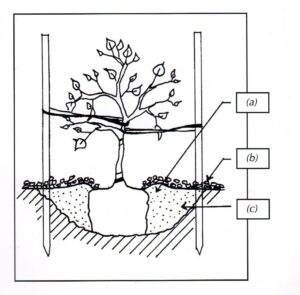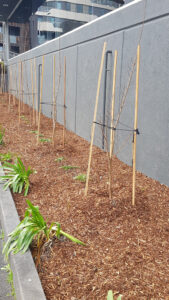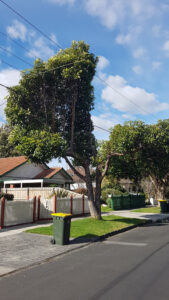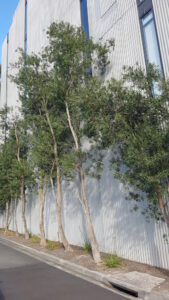
Giving trees their best start: It’s worth it
By John Fitzsimmons
The benefits of trees in our landscapes and streetscapes are many, widely published, and should be widely recognised and accepted. Monetary valuations of mature urban trees (2022 estimated values) can range up to $220,000 each, and annual maintenance costs, depending on management programs, can be $150/year or more for decades of benefit. So it’s worth giving our trees a good start.
Most people in the greenlife industry do know, and accept, the benefits of urban tree planting. In summary these include:
- heat mitigation, cooling
- reduced energy use
- pollution absorption
- stormwater runoff and flood mitigation
- habitat provision
- human physical and mental health benefits
- enhanced property values
- improved aesthetics, and
- improved passive recreation
Planting the right tree in the right place at the start saves time, money, and subsequent disappointment. Like any investment, do your homework and invest wisely.

Depending on management programs, species, and longevity, the lifetime costs of maintaining a street tree in Australia are, by one set of estimates, between $2800 and $6220, or up to $125 per year or more. Anything that can be done to double the lifespan of a street tree can reduce the annual management costs by about 30%.D
The basic monetary value of a tree has been based on an internationally accepted table of values devised by the American Council of Tree and Landscape Appraisers and the International Society of Arboriculture. In the base year of 1988 this was $A34 ($US27) per square inch of trunk basal area; this can be extrapolated to about $A87 per square inch of trunk basal area in 2022 values.
This can be converted to a value corresponding to centimetres in trunk Diameter at Breast Height (DBH) which is how the values referred to above were arrived at. The formula below can then be applied:
Value (V) = Basic Value ($) x Species (S) x Aesthetics (A) x Locality (L) x Condition
Species selection for any given site is a whole subject for another time. Suffice to say the broad primary considerations include:
- soil type and profile
- climatic and seasonal factors
- ultimate size and form, including root system characteristics
- compatibility (or otherwise) with nearby infrastructure and buildings
- lifetime maintenance requirements (including pruning, pest and disease control, irrigation or drainage)
- leaf, bark, or fruit drop (as hazards or maintenance issues)
One survey of local government across Australia found the following four areas frequently drove street tree plantings:
- visual and aesthetic
- environmental
- socio-cultural and community, and

- health
However, tree species characteristics, management and maintenance issues, visual and aesthetic benefits, site environmental factors, and problems caused by different species were reported to govern street tree species selection.
This survey found “in spite being the primary motives for planting, considerations for socio-cultural and community benefits and environmental benefits/ecosystem services had minor influence on street tree species selection.”
The suggestion arrived at was that Australian local government’s institutional culture could be biased by personal opinions on potential threats to a city’s vital infrastructure posed by street trees, resulting in the mismatch between planting and species selection principles.
Certainly, over recent years, there has been widespread reappraisal, by tree growers and their clientele, of the species being produced, offered and selected. And a concession that, especially in response to climate change, many species still prevalent across many Australian cities and towns, would be less likely to be selected and planted today.
In summary, the ideal street tree has a tall, straight trunk that spreads its branches above head height, is tolerant of pruning, resistant to drought and pollution, and be clean and tidy in its habit.
A professional grower of good trees will deliver a quality product in terms of correct branch structure and form, and also a functional, well-developed root system
So, you’ve identified a validated grower of quality trees and the young trees are on their way. What next?
First, take half a step back and confirm with your supplier that your seasonal timing for supply and planting is OK. In southern Australia, planting in late winter–early spring is common. Your supplier’s experience and specialist knowledge of their stock and your situation and expectations is valuable. Also, take care to source quality, well-grown trees with good form and well-developed healthy root systems. In most cases the latter will have been initiated by container growing using air pruning principles.

Where compacted, topsoils should be cultivated and subsoils, where hard pans exist, should be ripped or otherwise broken up. Good drainage is important.
Incorporation of up to 10% (by volume) of composted organic matter in the top 100mm of soil can benefit establishment in poorer soils. The addition of uncomposted organic matter to the planting hole is not recommended. In fact, common advice suggests adding fertiliser to the rootzone while roots are still establishing may be unproductive (but) discuss this with your expert supplier.
The planting hole should be two to three times the width of the root ball, with sloping sides, but no deeper than the root ball. After the young tree is put in, the hole should be back-filled with soil from the same site and firmed progressively. Eliminate air pockets by watering periodically during backfilling. A low berm or bund should be formed to form a watering basin around the trunk. This may need to be enlarged as the young tree develops. The top of the root ball should be flush with the finished edge of the hole.
A 75mm thick layer of mulch should overlap undisturbed soil around the hole but NOT be in contact with the trunk.
Once drainage is considered, irrigation becomes vital. One set of guidelines suggests that, for a root zone of 75-100 litres, a tree height of 3 to 4 metres and trunk diameter of 50-75mm, around 12 litres of water per week should be considered. Note there are a number of suggested indicative irrigation requirements for young trees.
Ex-Burnley tree specialist Dr Peter May has been quoted as saying North American references suggest rates of at least 4 litres/week/25mm of trunk diameter. However, in southern Australia our sporadic summer rainfall implies added irrigation is the only way for watering trees.
Maintaining mulch coverage (up to 75mm) to improve water holding capacity, and effective weed/competition suppression, will help matters.
Watering should be slow (to avoid runoff) and deep, and focused on the root ball – a newly-planted tree can only access moisture that is within its root ball; later it should have access to adequate moisture beyond the original planting hole. If the surrounding soil is not irrigated you will not get adequate root elongation into the surrounding soil volume. Water weekly and more often in hot and/or windy weather.
A well-grown and well-planted tree should not be staked tightly, if at all. Research has shown that unstaked trees establish faster, and develop stronger trunks and roots. Some movement will promote root system expansion and anchorage. However, staking may be needed to prevent pedestrian or mechanical impacts, or where vandalism is an issue.
The tree is usually considered “established” when it has regenerated enough roots to keep it alive without additional irrigation. This can be anything from three months to three years depending on species, size when planted, situation, and initial care. Compare growth rates before and after transplanting. The growth rate will slow immediately after transplanting and recover to pre-transplanting levels as the root system regenerates and post-planting stress is reduced.
The death of newly planted trees is often attributed to poor quality plants, insects or disease and yet it has been observed that more plants die from being planted too deep, getting too much or too little water, poor drainage, poor soil preparation or no ongoing maintenance program to support proper establishment and long-term survival. Ultimately over-watering is considered the major reason for young trees dying. A lack of water will not necessarily kill the tree but will retard root development needed for successful establishment. There needs to be moisture available in the soil for the tree at all times transpiration is taking place – not just when work schedules dictate. And any irrigation needs to be matched to prevailing weather conditions and growth stage.
There are many guides to tree water requirements post-planting
| Trunk Diameter | Watering Requirements | Approx. Irrigation Volume |
| 50mm | Daily for 2-4 weeks; every other day for 2 months; weekly until established. | 11-23 litres |
| 100mm+ | Daily for 2 months; every other day for 5 months; weekly until established. | 45 litres |
| Container Size | Tree Diameter | Trunk Diameter | Approx. Irrigation per week |
| 33cm | 1.3-2m | 25mm | 4 Litres |
| 40cm | 2.31-2.8 | 30-45m | 5-8 Litres |
| 60cm | 3-4m | 50-75m | 9-12 Litres |
All images supplied by John Fitzsimmons
